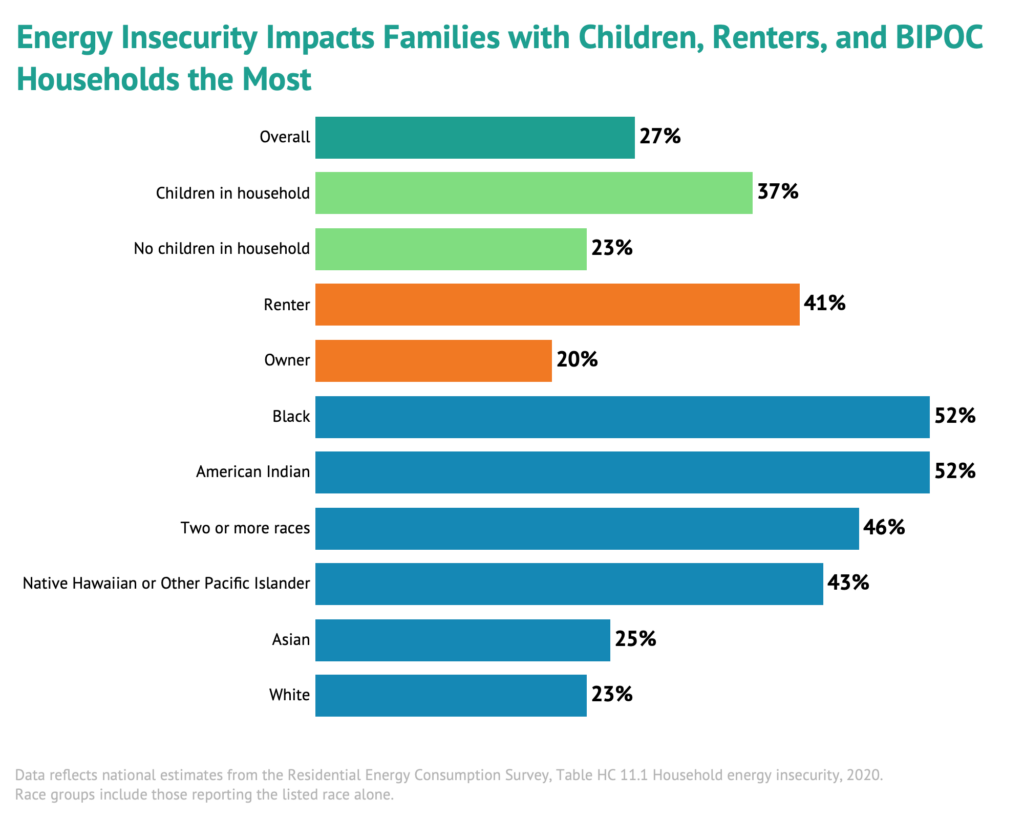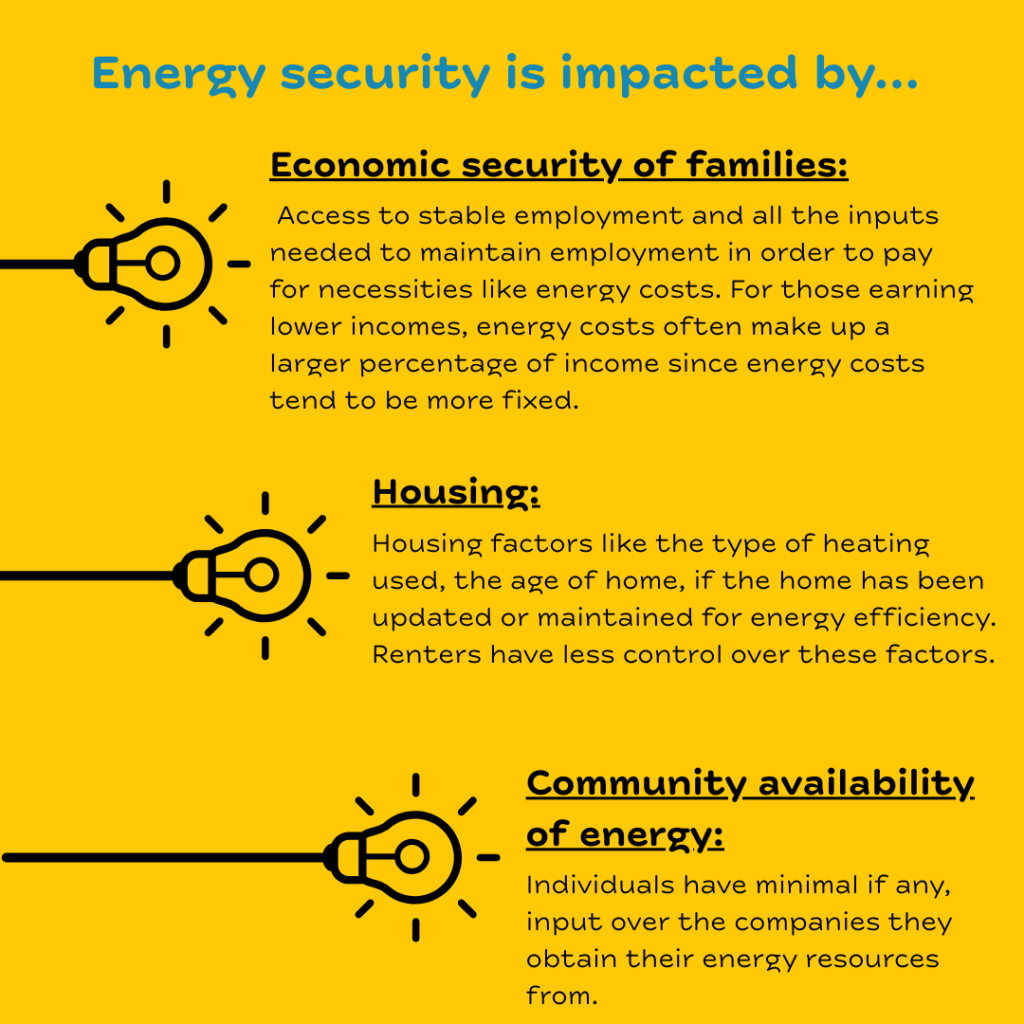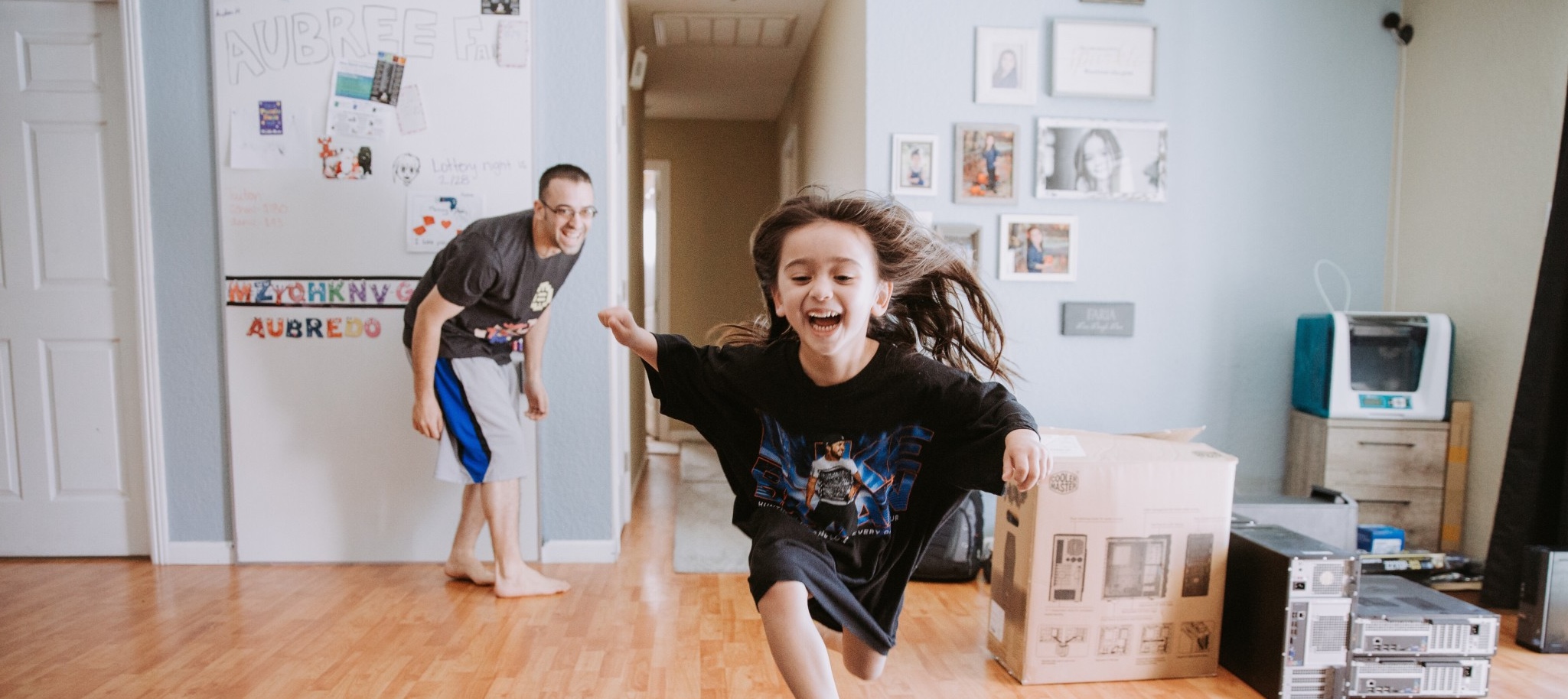Energy Security: Essential for Children’s Well-Being
May 2025
Access to Affordable and Reliable Energy Matters for Children’s Well-Being
Not every family in North Dakota has the same access to affordable energy. When families struggle to afford energy costs, their health and well-being suffer. Reliable access to energy ensures a home is heated and cooled during extreme weather, a family can cook and store food, and people can access the internet for things like telehealth appointments and education needs.
Nationally, more than one out of four households experience some form of energy insecurity, meaning they struggle to afford their basic energy needs.1 As a result, these families make tradeoffs with other necessities to make ends meet. For example, 20 percent of households cut back on or went without food or medicine to pay energy costs, 10 percent left their homes at an unhealthy temperature, and 4 percent were unable to use heating equipment due to delayed repair. The inability to consistently afford energy costs results in 10 percent of households receiving a disconnect or delivery stop notice. Energy insecurity challenges are heightened for families living on lower incomes, families with children, those who rent their homes, and Black, Indigenous, and other families of color.1
Energy security for families is complex. Economic security directly impacts whether a family has the resources to cover energy costs along with other essentials like housing and food.2 Housing also impacts energy security. Different fuel types used in homes impact cost, and so does the age of the home and whether it has been maintained or updated to be more energy efficient. Renters can be at a particular disadvantage, having little control over the heating and cooling systems and whether they are updated, maintained, and fixed. Energy costs also differ by community, and often, energy companies provide little opportunity for input and control for those impacted by their policies.

Energy security matters because it impacts the health and well-being of families across North Dakota. Research has shown that children living in energy-insecure families are more prone to food insecurity, hospitalizations, and developmental concerns.3 Families experiencing energy insecurity also report more respiratory illness, poor sleep, and increased stress and mental health concerns.2 Many families dealing with energy insecurity face cumulative hardships and burdens given the linked nature of stable and safe housing, financial stability, and health.

Energy Costs Are Higher in Reservation and Rural Communities
People living in reservation and rural communities in North Dakota spend more on energy costs each year, ranging from 26 percent to 73 percent higher compared to statewide costs.4,5 In addition to paying higher costs, reservation and rural communities also experience a higher energy cost burden, spending a higher percentage of their income on energy costs.

Given the relationship between energy security, access to safe and affordable housing, and economic security, understanding housing challenges in Tribal communities is critical when considering addressing energy security. Families living on Tribal lands are almost five times more likely to live in poor housing conditions compared to the general population and are astronomically more likely (1,200 times) to live in homes with heating issues.6 Addressing housing challenges in Tribal communities could go a long way to improve energy security too.

The disparities in energy costs, energy security, and housing quality for Tribal communities are outcomes of policies and programs that have systematically discriminated against Indigenous people across many generations. For example, two Tribal nations within North Dakota lived and relied on land along the Missouri River. The fertile land provided resources for agriculture and economic security. When the federal government built dams along the Missouri River in the mid-20th century, Tribal nations were forced to give up land that was rightfully theirs and relocate to land without the same access to natural resources.7 The loss of this land was significant for Tribal communities and made it harder to remain self-reliant and build economic prosperity. The stolen land, paired with a lack of investment in the areas Tribal nations were relocated to, has resulted in present-day disparities in housing conditions, energy security, and access to affordable utilities.8

North Dakota Leaders Can Help Improve Energy Security
Leaders across North Dakota should prioritize solutions to improve energy security, particularly for Tribal and rural communities. Implementing solutions to prevent utility shut-offs, particularly during the coldest months, can ensure families in crisis are not faced with an impossible decision on how to keep their homes warm or go without other essential needs. Forty other states and D.C. have policies in place related to cold weather disconnection protection.14 However, North Dakota’s unique landscape of utility cooperatives makes it challenging to pass a true statewide moratorium on winter shut-offs.
For example, Montana has a statewide moratorium on winter utility shutoffs between November 1 and April 1, with more strict protections for households where a person has a disability or is 62 or older.15 However, this protection only applies to public utilities governed by the Public Service Commission and does not apply to more localized electric cooperatives.16 Each cooperative in North Dakota would need to pass its own policy related to preventing winter shutoffs. The North Dakota Association of Rural Electric Cooperatives could promote best practices for winter shutoff policies that support families across the state. Community members can engage with their local utility provider or cooperative to add critical voices to the conversation regarding energy costs, energy security, and protections for families in crisis.
Another strategy to support families in crisis due to a utility shutoff is to invest additional state funding to bolster existing programs like the Low-Income Home Energy Assistance Program (LIHEAP), which can help cover heating costs for families in crisis. In North Dakota, only 16 percent of income-eligible families received LIHEAP Heating Assistance in 2023.17 North Dakota is seeing an increase in the number of families applying for LIHEAP.18 The growing gap in denied applications on the cusp of North Dakota's coldest months demonstrates a need for policymakers to further invest in energy security resources.
Footnotes
- U.S. Energy Information Administration, Office of Energy Demand and Integrated Statistics, “Residential Energy Consumption Survey Table HC11.1 Household energy insecurity, 2020.”
- Hernandez, D., “Energy Insecurity And Health: America’s Hidden Hardship,” Health Affairs, June 2023.
- Hernandez, D., “Understanding ‘energy insecurity’ and why it matters to health,” Social Science & Medicine, Oct. 2016.
- U.S. Department of Energy, “Low-Income Energy Affordability Data (LEAD) Tool,” 2022, downloaded on Dec. 5, 2024.
- University of North Dakota School of Medicine & Health Sciences, Center for Rural Health, “North Dakota County Classification,” Mar. 2011.
- National Low Income Housing Coalition, “Housing Needs on Native American and Alaska Native Tribal Lands,” Mar. 2024.
- State Historical Society of North Dakota, “Lesson 1: Changing Landscapes, Topic 1: Garrison Dam and Diversion, Section 3: The Taking,” accessed Apr. 17, 2025.
- U.S. Commission on Civil Rights, “Broken Promises: Continuing Federal Funding shortfall for Native Americans,” Dec. 2018.
- State Historical Society of North Dakota, “Lesson 3: Building Communities, Topic 2: Cooperatives, Section 3: North Dakota Electric Co-ops,” accessed Apr. 17, 2025.
- North Dakota State University Libraries, “Fargo, North Dakota: Its History and Images, Gas and Electric Service,” accessed Apr. 17, 2025.
- U.S. Department of Energy, “Tribal Electricity Access and Reliability,” Aug. 2023.
- North Dakota Association of Rural Electric Cooperatives, “N.D. Electric Distribution Cooperatives,” accessed Apr. 17, 2025.
- North Dakota Public Service Commission, “Protection from Electric and Natural Gas Disconnections,” Feb. 2025.
- U.S. Department of Health and Human Services, Administration of Children and Families, “LIHEAP Clearinghouse, Disconnect Policies,” July 2024.
- Montana Secretary of State, Administrative Rules of Montana, “38.5.1410 Termination of Service During Winter Months,” 1980.
- Montana Public Service Commission, Consumer Assistance Program, “Winter Moratorium Explained,” Sep. 2016.
- U.S. Department of Health and Human Services, Administration of Children and Families, “LIHEAP Performance Management, Percent of Federally Income-Eligible Households Receiving LIHEAP Heating Assistance by Vulnerable Group – North Dakota.”
- Department of Health & Human Services, “Low Income Home Energy Assistance.”

